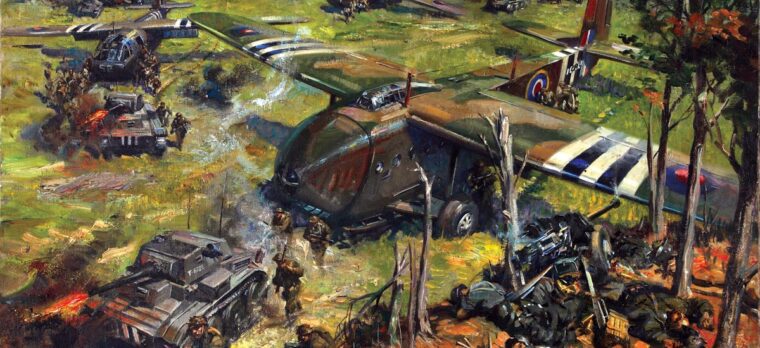
airborne
The Los Banos Raid: WWII’s Finest Allied Mission?
By Donald J. Roberts IIAs the nine C-47s flew closer to the drop zone, the lead plane descended to an altitude of four hundred feet. Read more

airborne
As the nine C-47s flew closer to the drop zone, the lead plane descended to an altitude of four hundred feet. Read more

airborne
Paratrooper Lt. Col. Bill Yarborough was flying into hell. As he prepared to jump from a Douglas C-47 transport plane then approaching the coast of Sicily, hundreds of American antiaircraft gunners below started shooting at him. Read more

airborne
By summer’s end 1944 Adolf Hitler, along with much of his staff, began to realize that Germany was in serious danger of losing the war. Read more

airborne
General George S. Patton, Jr., once said, “An army is like a piece of cooked spaghetti. You can’t push it, you have to pull it after you.” Read more

airborne
Late on the night of June 5, 1944, while American paratroopers were on their way to drop behind Utah Beach, another, smaller air armada carrying 170 British airborne troops was also dashing headlong into battle like an aerial cavalry charge towards the far eastern flank of the Normandy invasion site. Read more

airborne
U.S. Army Sergeant Vere Williams listened to his instincts as his landing craft approached the beach. It was August 15, 1944, and his unit, the 157th Infantry Regiment of the 45th Division was part of the invasion force for Operation Dragoon, the landings along France’s Mediterranean coast. Read more

airborne
By John W. Osborn, Jr.
When world war engulfed Europe for the second time in a generation, the Netherlands placed its faith in the diplomatic delusion that it could remain neutral like it had during World War I. Read more

airborne
At the town of Schmidt in the Hürtgen Forest, it was hard to see through the thick mist and steady drizzle on the cold and damp morning of Saturday, November 4, 1944. Read more

airborne
March 24, 1945. The green light flashed from the C-47 tug plane, prompting the glider pilot being pulled behind it to release his tow rope over Landing Zone N, just east of the Rhine River. Read more

airborne
Early in 1944, German Field Marshal Erwin Rommel, the defeated hero of North Africa and now head of Army Group B in France, was tasked with strengthening the Atlantic Wall defenses against Allied invasion. Read more

airborne
The two exits from the American landing zones at Utah Beach were entrusted to the 502nd Parachute Infantry Regiment, 101st Airborne Division. Read more

airborne
Sergeant William R. Kelly crashed through the treetops, slamming to a stop when his parachute canopy caught on some branches. Read more

airborne
Shellfire rocked the aid station. A ceiling beam cracked, raining down plaster. One explosion obliterated a window, hurling stone, wood, and glass shards into the room. Read more

airborne
By the time the attack on Pearl Harbor plunged the United States into World War II, Japan had been preparing for an all-out offensive in the Pacific for months. Read more

airborne
“DON’T WORRY, GUYS––the Airborne is here!” shouted Private Howard Buford to the worn-out GIs he and his fellow paratroopers passed on the snowy road through Bastogne in the early hours of December 19, 1944. Read more

airborne
The jerk of the canopy opening was a reassuring sensation. Not so reassuring was the storm of small arms and artillery fire that roared up from the ground. Read more

airborne
In March 1942, the Japanese juggernaut that had steamrolled across the Pacific during the early months of the war landed at Lae village at the southwestern corner of the Huon Peninsula of Papua New Guinea. Read more

airborne
Next to sleep, warmth was the most sought after commodity of the frontline soldiers who froze in their foxholes, stomping their feet or puffing on cigarettes to keep warm. Read more

airborne
When the United States Army mobilized for defense in the fall of 1940, the peacetime draftees, National Guardsmen, reservists, and regulars carried Model 1903 Springfield rifles; the Guardsmen wore puttees; and all the soldiers covered their heads with the doughboy helmet—head-to-foot relics of World War I. Read more

airborne
This article was provided by Martin Cherrett, whose blog, World War II Today, provides a unique way military history enthusiasts can understand and experience the Second World War. Read more